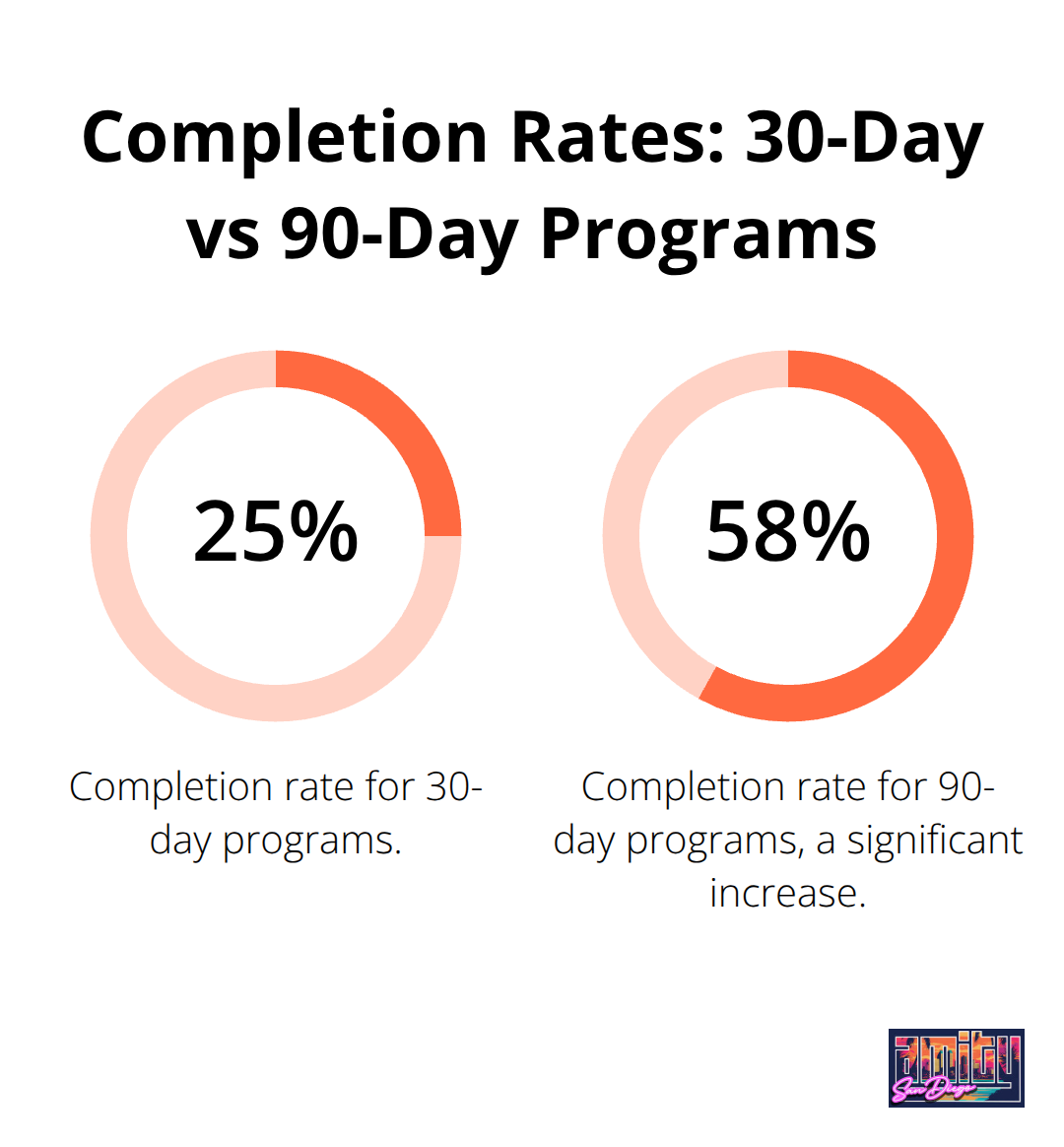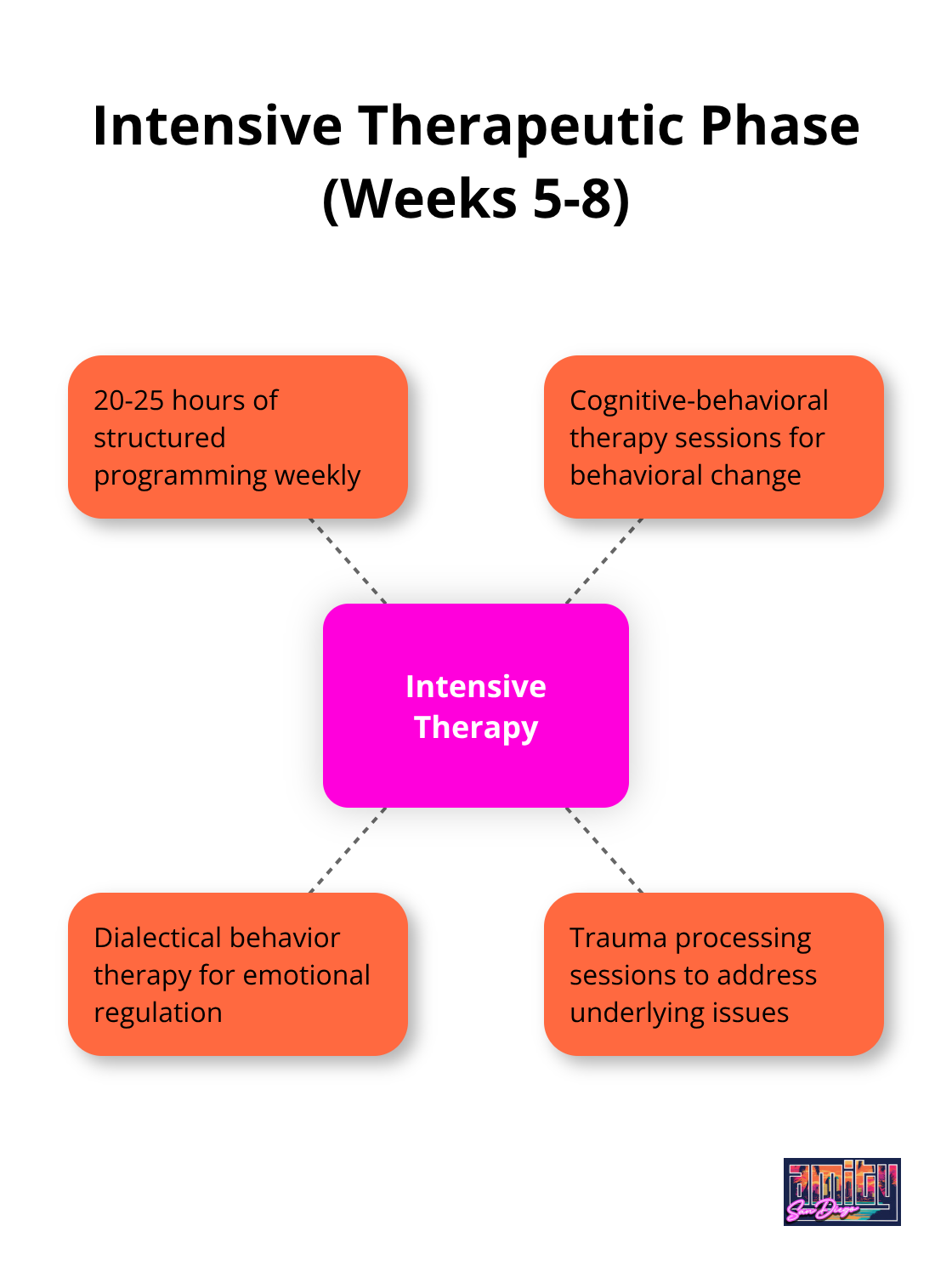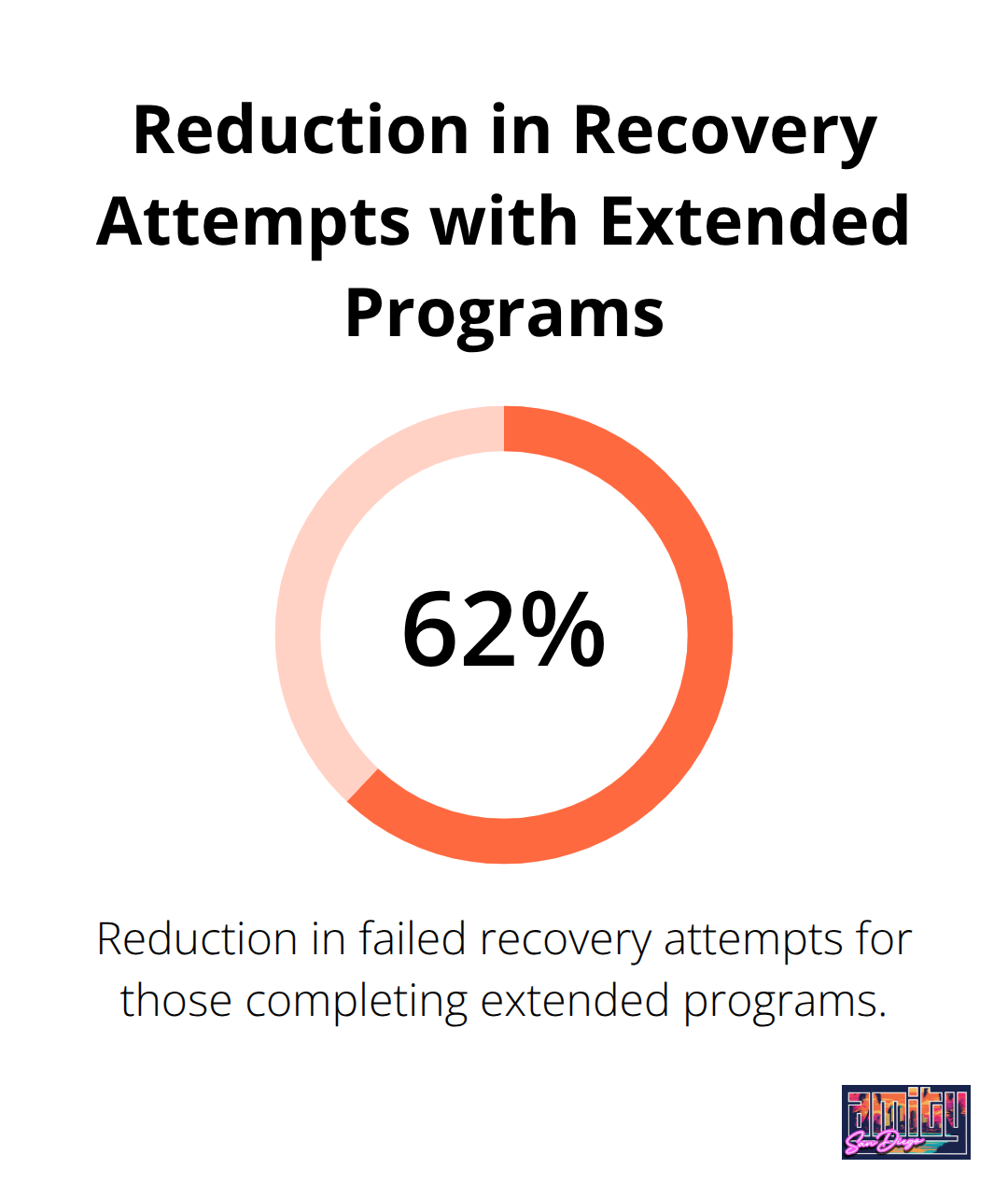Most addiction treatment programs last 30 days, but research shows this isn’t enough time for lasting recovery. Studies indicate that 90-day treatment programs produce significantly better outcomes than shorter alternatives.
At Amity San Diego, we’ve seen how extended treatment allows the brain to heal properly and gives people the tools they need for sustained sobriety. The extra time makes all the difference in building a solid foundation for long-term recovery.
Why Extended Treatment Creates Better Recovery Outcomes
Addiction fundamentally rewires brain chemistry, and these changes take months to reverse properly. The National Institute on Drug Abuse research shows that neuroplasticity improvements take time to stabilize dopamine and serotonin levels. Shorter programs simply don’t provide enough time for the brain’s reward system to reset itself.
Research Proves Extended Programs Work Better
Studies from the Treatment Research Institute demonstrate that clients who complete 90-day programs show 65% higher success rates at the one-year mark compared to those in 30-day programs. The completion rate jumps from 25% in month-long programs to 58% in extended treatment. These statistics reveal why addiction treatment San Diego professionals consistently recommend longer programs for sustainable recovery.

Mental Health Integration Requires Extended Time
Co-occurring disorders affect many people who seek addiction treatment, yet professionals need extensive time to address trauma and underlying psychiatric conditions. Depression, anxiety, and PTSD symptoms often surface weeks into recovery once the numbing effects of substances wear off. Research from SAMHSA indicates that dual diagnosis treatment needs a minimum of 12 weeks to properly stabilize both addiction and mental health symptoms.
Extended Programs Allow Real-World Practice
The first 30 days focus on detox and initial stabilization, while weeks 5-12 allow for deeper therapeutic processing and skill development. Extended treatment provides time to practice new behaviors in real-world situations. Cognitive-behavioral therapy effectiveness increases significantly when clients have 90 days to implement learned strategies.
Success Rates Improve With Longer Treatment
The mean number of recovery attempts before achieving lasting sobriety is 5.35 according to recent studies, but this drops to 2.1 attempts for individuals who complete extended programs (a 62% reduction in failed attempts). Clients develop genuine confidence in their recovery tools when they’ve had three months to test and refine their coping strategies under professional guidance.
These extended timeframes create the foundation necessary for what happens during the actual treatment process.
What Happens During 90 Days of Treatment
The first 30 days focus primarily on detox and immediate medical needs. Clinical teams conduct thorough evaluations that include psychological tests, medical examinations, and addiction severity assessments to create individualized treatment plans. During this phase, withdrawal symptoms subside and clients begin basic group therapy sessions. Medical professionals monitor vital signs, sleep patterns, and nutritional needs while they address any co-occurring mental health conditions. Treatment retention remains a critical factor during this stabilization period, which makes this phase essential for long-term success.
Intensive Skill Development Takes Center Stage
Weeks 5-8 represent the most intensive therapeutic phase where real behavioral change occurs. Clients participate in 20-25 hours of structured programming weekly, which includes cognitive-behavioral therapy, dialectical behavior therapy, and trauma processing sessions. Cognitive behavioral therapy has demonstrated efficacy as both a monotherapy and as part of combination treatment strategies for substance use disorders. Group therapy sessions focus on practice with real-world scenarios, trigger management, and communication skill development. Individual therapy sessions address underlying trauma and family dynamics that fuel addictive behaviors.

Medical Monitoring Continues Throughout Treatment
Healthcare professionals maintain close supervision of physical and mental health throughout the entire 90-day period. Physicians adjust medications as brain chemistry stabilizes and monitor for any emerging health complications. Nurses track sleep quality, appetite changes, and energy levels to identify potential warning signs early. Mental health clinicians assess mood stability and anxiety levels weekly to modify treatment approaches as needed. This continuous medical oversight prevents complications that could derail recovery progress (particularly important for clients with multiple substance dependencies).
Transition Planning Prevents Relapse
The final month concentrates on relapse prevention and reintegration strategies. Clients practice weekend passes, job interview skills, and family relationship rebuilding under clinical supervision. Treatment teams develop detailed aftercare plans that include outpatient therapy schedules, support group connections, and crisis management protocols. Research shows that abstinence rates can reach 57% with effective treatment approaches compared to standard care. This phase includes medication management protocols for those who require ongoing pharmaceutical support and connections to alumni networks for peer accountability (essential for maintaining long-term recovery momentum).
These comprehensive treatment phases create measurable improvements that extend far beyond the initial 90-day period. For those seeking comprehensive addiction treatment San Diego offers specialized programs designed to support lasting recovery.
How Do 90-Day Programs Create Lasting Change
Extended treatment programs produce dramatically different outcomes than their shorter counterparts, with relapse rates that vary significantly between program lengths according to recent studies. The Treatment Research Institute found that clients who complete extended programs maintain sobriety at higher rates after one year compared to those in month-long treatment. These statistics represent real people who built sustainable recovery foundations through extended care.
The brain’s dopamine systems require extended time to stabilize after substance use stops, which explains why shorter programs face challenges. NIDA research demonstrates that neuroplasticity changes accelerate during extended treatment periods, when the brain begins to produce natural reward chemicals again. Clients who complete 90-day programs report significantly fewer cravings and better emotional regulation because their brain chemistry has time to reset. This biological process cannot be rushed or compressed into shorter timeframes.
Cognitive-behavioral therapy techniques require months of practice to become automatic responses during stressful situations. Studies show that clients need time to form new habits, but addiction recovery requires the replacement of multiple destructive patterns simultaneously. Extended programs allow people to practice coping strategies in various scenarios – family conflicts, work stress, social situations – under clinical supervision. The result is genuine confidence in recovery tools rather than theoretical knowledge that crumbles under real-world pressure.

Brain Chemistry Requires Extended Healing Time
The brain’s dopamine systems require extended time to stabilize after substance use stops, which explains why shorter programs face challenges. NIDA research demonstrates that neuroplasticity changes accelerate during extended treatment periods, when the brain begins to produce natural reward chemicals again. Clients who complete 90-day programs report significantly fewer cravings and better emotional regulation because their brain chemistry has time to reset. This biological process cannot be rushed or compressed into shorter timeframes.
Skill Development Happens Through Consistent Practice
Cognitive-behavioral therapy techniques require months of practice to become automatic responses during stressful situations. Studies show that clients need time to form new habits, but addiction recovery requires the replacement of multiple destructive patterns simultaneously. Extended programs allow people to practice coping strategies in various scenarios – family conflicts, work stress, social situations – under clinical supervision. The result is genuine confidence in recovery tools rather than theoretical knowledge that crumbles under real-world pressure.
Recovery Capital Builds Through Time Investment
SAMHSA data indicates that individuals with strong recovery capital – including stable housing, employment prospects, and social support networks – achieve higher long-term success rates. Extended programs provide time to rebuild these essential foundations that shorter programs simply cannot address adequately. Clients develop meaningful relationships with peers, practice job interview skills, and repair family connections gradually rather than rush through surface-level changes that don’t last (which often leads to relapse within months).
Final Thoughts
The evidence overwhelmingly supports 90-day treatment programs over shorter alternatives. Research from the Treatment Research Institute shows 65% higher success rates at one year for extended programs, while completion rates jump from 25% to 58%. These statistics represent real outcomes for people who invested in comprehensive recovery.
The financial and emotional costs of repeated treatment attempts far exceed the initial investment in extended care. With the mean number of recovery attempts at 5.35 for shorter programs versus 2.1 for 90-day treatment programs, the math speaks clearly. Extended treatment prevents the cycle of relapse and readmission that devastates families and drains resources (particularly when families face multiple failed attempts).
We at Amity San Diego understand that comprehensive treatment requires courage and commitment. Our evidence-based approach combines medical expertise with personalized care in a supportive environment. Recovery is possible for everyone, and Amity San Diego provides the clinical excellence and compassionate support needed for lasting change.

